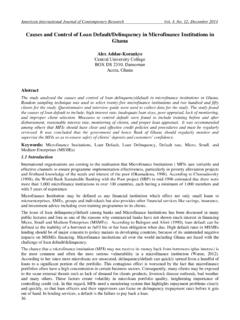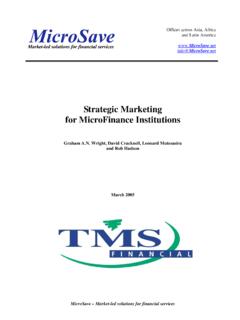Transcription of THE EFFECT OF INTERNAL CONTROLS ON FINANCIAL …
1 International Academic Journal of Economics and Finance | Volume 2, Issue 3, pp. 112-140 112 | P a g e THE EFFECT OF INTERNAL CONTROLS ON FINANCIAL PERFORMANCE OF microfinance institutions IN KENYA Gabriel Mwaniki Ngari Master of Business Administration, Jomo Kenyatta University of Agriculture and Technology, Kenya 2017 International Academic Journal of Economics and Finance (IAJEF) | ISSN 2518-2366 Received: 30th April 2017 Accepted: 12th May 2017 Full Length Research Available Online at: Citation: Ngari, G. M. (2017). The EFFECT of INTERNAL CONTROLS on FINANCIAL performance of microfinance institutions in Kenya.
2 International Academic Journal of Economics and Finance, 2(3), 112-140 International Academic Journal of Economics and Finance | Volume 2, Issue 3, pp. 112-140 113 | P a g e ABSTRACT This paper is on EFFECT of INTERNAL CONTROLS on FINANCIAL performance of microfinance institutions in Kenya. microfinance institutions in Kenya have meticulous responsibility of establishing appropriate INTERNAL CONTROLS since failure to do so open loopholes for misappropriation of resources. On the other hand excessive INTERNAL CONTROLS procrastinate growth and development. The study looked at segregation of duties, vouching, authorization and approval of accounting transactions and INTERNAL audit functions as specific objectives.
3 Descriptive and diagnostic research designs were used in collection, measurement and analysis of data whilst multiple regression analysis and descriptive statistics to establish the relationship and strength upon which independent variables affect dependent variable. From the population of 53, 21 institutions were sampled using stratified and simple random sampling methods. The study found out segregation of duties, vouching, authorization and approval of accounting transactions and INTERNAL audit functions affect FINANCIAL performance significantly. On segregation of duties the study concluded microfinance institutions should set stages in accounting processes as well as INTERNAL check hence recommending proper handling of division of labour, job rotation and job description.
4 Secondly on vouching officers should enquire thoroughly, review support documents and accounts history of the clients hence recommending training of officers and processing at central point. On authorization and approval of accounting transactions the study concluded microfinance institutions should limit the number of officers authorizing payments and bank accounts signatories. Thus the study recommended relevant staff training and adequate provision of policies and procedure manuals. Lastly on INTERNAL audit functions the study concluded, in reviewing FINANCIAL reports auditors must familiarize themselves with relevant international auditing and accounting standards while adhering to professional ethics.
5 Additionally the study has highlighted areas for further research as other institutions besides microfinance institutions especially for comparison. Key Words: INTERNAL CONTROLS , FINANCIAL performance, microfinance institutions , Kenya INTRODUCTION INTERNAL control is a process, effected by an entity s board of directors, management and other personnel, designed to provide reasonable assurance regarding the achievement of a firm s objectives in the effectiveness and efficiency of operations, reliability of FINANCIAL and management reporting, compliance with applicable laws, regulations and protect the organization s reputation (Kaplan, 2008).
6 There are many CONTROLS that an MFI can institute to protect it resources against loss to improve performance. A collection of INTERNAL CONTROLS put in place by the MFI is what forms INTERNAL control system (ICS). An INTERNAL control is a topic that cuts across a number of disciplines including FINANCIAL accounting and auditing. It can be traced back to ancient times. In Hellenistic Egypt there was dual administration where one side was involved in collation of taxes while the other supervising them. Sacking of Troy was International Academic Journal of Economics and Finance | Volume 2, Issue 3, pp. 112-140 114 | P a g e one of the examples of weaknesses of INTERNAL CONTROLS .
7 INTERNAL CONTROLS became apparent at the beginning of 21st century following major corporate scandals (PABC 2006). In Kenya the giant Uchumi supermarket went under in June 2006 due to insolvency and it securities stopped trading at Nairobi stock exchange ( ). It is until the Government of Kenya injected some amount to bail it out of the liquidity trap. The most apparent incident is the fall of two commercial banks in a span of less than five months. Fall of Dubai bank in 14th August, 2015 followed by Imperial bank in 13th October, 2015. The reason cited in the case of Dubai bank was serious liquidity and capital deficiencies that may render inability to meet FINANCIAL obligations as and when they fall due.
8 In the case of Imperial bank the CBK reported unsafe or unsound business conditions where the appointed Kenya Deposit Insurance Corporation (KDIC) will manage it for 12 months while investigating inappropriate banking practices. Serious ramifications followed when customers could not get back their deposits, numerous jobs were lost and many creditors could not be easily paid. This happened despite both banks being under supervision of the CBK. microfinance institutions are FINANCIAL institutions that provide mode of finance designed to provide low income individuals with the means to become self-sufficient.
9 A microfinance institution issue small loans to those marginalized from normal modes of finance with the intention of helping the poor prosper by allowing them to save or borrow money (Campbell R. Harvey 2012). They earn FINANCIAL revenue from loans and other FINANCIAL services in form of interest, fees, penalties and commissions. FINANCIAL revenue also includes income from other FINANCIAL assets, such as investment income. An MFI s FINANCIAL activities also generate various expenses, from general operating expenses and the cost of borrowing to provisioning for the potential loss from defaulted loans.
10 The main aim of microfinance in Kenya was and is to address poverty. From 1980 to 2000, NGO s and multinational agencies were behind many MFI s. They were co-financing agencies. The co-financing agencies were concerned with alleviation of poverty and creation of employment as well as increasing income for the poor. They were also concerned with improving social capabilities availability and access to resources and participation in decision making. Lending by microfinance is either group or individual based or minimalist verses intergraded approach. Group based which take the form of Grameen Model is common.










